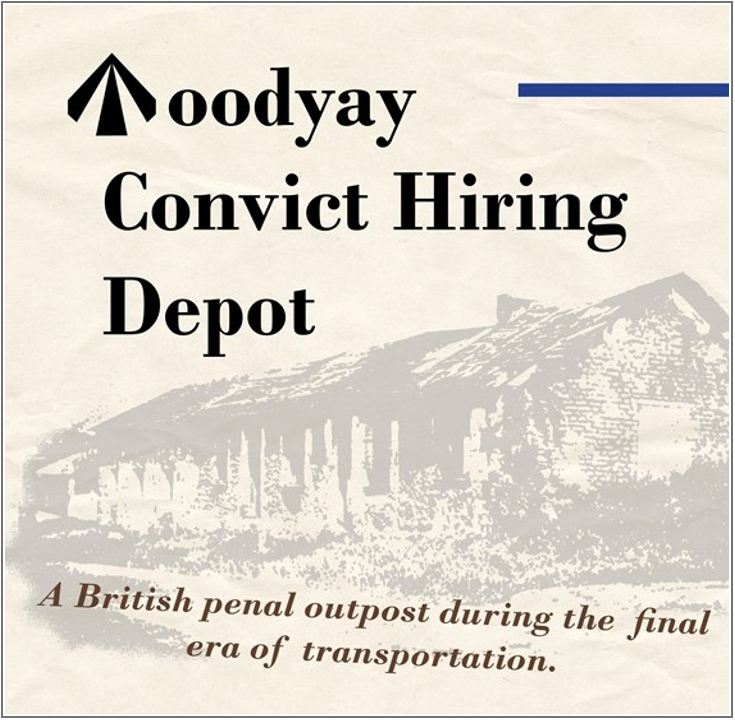

This digital exhibition is based on the exhibition presented at the Newcastle Gaol Museum, Toodyay, between October 2017 and February 2019.
 The Convict System in Western Australia, 1849–1868
The Convict System in Western Australia, 1849–1868
Western Australia was declared a penal settlement in 1849, and became the last of the Australian colonies to receive convicts from Britain. The first transport ship, the Scindian, arrived in June 1850.
Convict Establishment
The convict system was based in Fremantle. Smaller Convict Hiring Depots operated in outlying areas. These were located at Mount Eliza, North Fremantle, Guildford, Albany, Bunbury, Lynton (north of Geraldton), York and Toodyay.
The newly-arrived convicts were housed at Fremantle Prison after it opened in 1855.

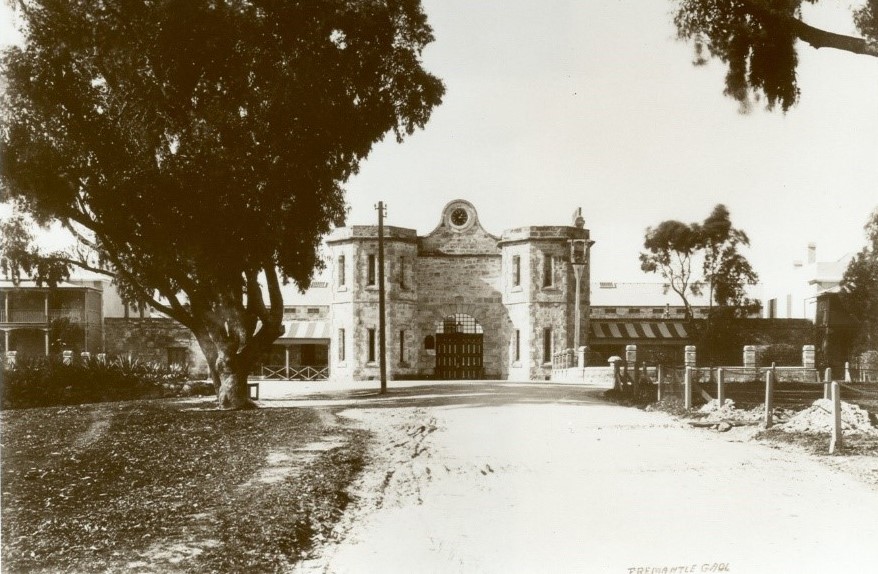
Front gate of Fremantle Prison circa 1895 (Image: Ron Davidson and the Fremantle Prison Collection).

Classes of Convict
Probationary Convict
Initially prisoners would become Probationary Convicts, employed on public works in Fremantle while under guard. In later years, out-stations established along major roads were also manned by Probationary Convict road-working gangs.


Convict-era road base adjacent to Toodyay Road, approximately 3km from Toodyay in the direction of Perth. Hand-cut and laid stones, hewed locally, build up gullies for accessibility. Uncovered by Main Roads during widening and straightening roadworks in June 2019 and left intact upon completion (Image: M. Eberle, 2019).


Key from the Baylup (Bailup) lock-up. The Baylup Police Station and lock-up on the road to Toodyay were built by convict labour. The station was closed on 1 January 1874, and burnt to the ground in an 1882 bushfire (Image: Shire of Toodyay, 2001.702).

Ticket of Leave
Well-behaved convicts were granted a ticket of leave (TL) and could work for wages. A TL holder was sent to a Hiring Depot to find employment in the surrounding district. They were not allowed to leave that area without special permission and had to report to the local Magistrate at least every six months. They did, however, have some control over who they worked for.




Conditional Pardon
After demonstrating good behaviour, a TL holder could receive a Conditional Pardon (CP). At first this allowed him to leave Western Australia but not return to Britain. In practice however, CP men found in the early years they could leave WA for the eastern colonies or South Africa, and then travel on to England as free men.
Certificate of Freedom
After complaints from the eastern Australian colonies, an additional release condition – a Certificate of Freedom – was introduced. This prevented men from moving interstate until their full sentence had been served.
Expiree
As an expiree, a convict's full length of sentence had been served and they were free. Ex-convicts, however, found it difficult to find work or be treated as equals. They were not allowed to be members of associations and were subject to prejudice in business dealings. The hated term also followed former convicts in all official documentation.
Free Pardon or Full Pardon
This meant the convict was released from serving his full sentence due to an act, e.g. saving a life. Very few convicts received a full pardon which would give them the same rights as other free citizens.
In the early years, the convicts chosen for transportation were serving short sentences and many soon received the Ticket of Leave (some upon arrival). In later years this was not the case, and the numbers of the probationary class of convicts increased.
The last convict ship, the Hougoumont, arrived in January 1868. The Convict Establishment in Western Australia then began to wind down, although it was not until 1886 that Fremantle Prison was finally handed over to the Colonial Government to manage.



Police Visitor's Book, 1977-1888. In official documents such as this census record of the people in the Toodyay district, ticket of leave convicts continued to be identified by the initials TL. See the entry above dating from 18 August 1880 for "George Stephens T.L.", labourer at Seven Springs. George arrived as a convict in 1858 with a sentence of 10 years, and received his TL six months later. In 1876 he was re-convicted for sheep stealing and sentenced to 6 years of penal servitude (Image: Shire of Toodyay, 2000.4).

Toodyay Convict Hiring Depot, 1851-1872
The Toodyay Convict Hiring Depot was a part of the Eastern District which also included the York Depot. Both sites were administered from Guildford. The original function of the Depot was to allow settlers to readily access ticket of leave labour.
1851-1856: Establishment
In August 1851, the Depot was first set up at the original Toodyay town site (now known as West Toodyay). Within a few months it relocated several kilometres upriver to a larger site.
In February 1852, building at the new site began. This was mostly completed by 1855. Ticket of leave holders stayed at the Depot only if they could not find work elsewhere.

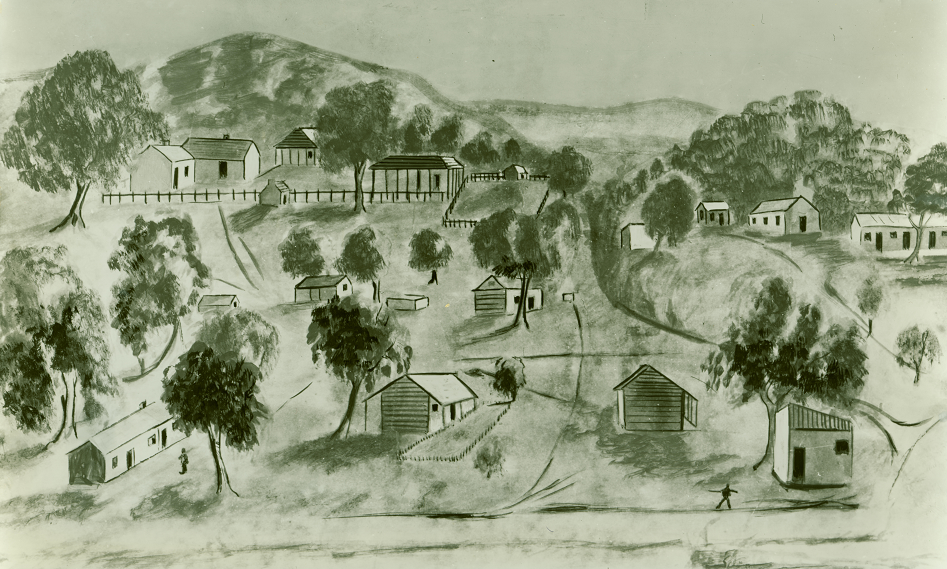 Toodyay Convict Hiring Depot 1854, probably painted by Lt. Edmund Du Cane (Image: Royal Western Australian Historical Society).
Toodyay Convict Hiring Depot 1854, probably painted by Lt. Edmund Du Cane (Image: Royal Western Australian Historical Society).

1856-1862: Contraction
Public debt in the Colony was high. The York and Toodyay Convict Hiring Depots were downgraded to “Branch Establishments” to save money. Only three staff would be required to look after the whole site. Payment for ticket of leave holders who lived at the Depot stopped. Those who were unable to find private employment were sent to the Guildford Depot.
The Commissariat staff withdrew, the horses were sold and the Infirmary was closed. The township of Newcastle was established and began to grow around the Depot. Part of the site was taken over by the Colonial Police.


Map of the Toodyay Convict Depot drawn up by Surveyor Hillman, 15 January 1861. Building number 8 identifies the Association Ward, also referred to as the Depot Barracks. In 1897, after the Barracks was demolished, a new Courthouse was built on the site. Today the Courthouse building is used as the Shire of Toodyay Council Chambers. The red buildings, located where the Newcastle Police Stables are today, were handed over to the Colonial Police in 1861. The long red building was the original wooden stables which burnt down in 1890. The Newcastle Gaol had not yet been built (Image: State Records Office, Item 27, Cons. 3850).

1862-1972: Second era of operation
As Britain’s penal system gradually reformed, it began dealing with more of its minor offenders at home. A higher proportion of serious offenders were then sent then to Western Australia.
The numbers of convicts requiring close supervision increased. Some regional depots were reopened to receive two classes of convicts (TL and probationary) who were kept segregated. The Toodyay Convict Depot catered for 120 men.
At Toodyay, Probationary Convicts, who now outnumbered ticket of leave persons, undertook public works such as road repairs and building the new Newcastle Gaol.
In February 1872, the Toodyay Convict Hiring Depot closed. The York Depot remained open for a further two years.

Convicts
Between 1850 and 1868, about 9720 convicts – all male – were sent from England to Western Australia on 37 ships. From 1850 to 1854, the convicts chosen for transportation were serving short sentences and many soon received their ticket of leave, but in later years this was not the case.


19th century handcuffs from the Shire of Toodyay heritage collection 2022.27 (Image: Phil Hart).

The following two convicts arrived in very different eras. Their fates also were also very different.

John Acton Wroth (arrived 1851)
Wroth was transported for forging an order for goods. He was 20 years old and educated. Wroth was sent to the York Convict Hiring Depot to work as a clerk.
In 1853, he received his Conditional Pardon. In 1854, he moved to the Toodyay Convict Hiring Depot where he was appointed clerk of courts. That year he married Bridget Ellis, a recent emigrant, and they would go on to have six children.
To supplement his income, Wroth took on extra work including the roles of postmaster and teacher. He became a well-regarded member of the Toodyay community.
Wroth died in 1876 after contracting Typhoid.


John Acton Wroth (Image: Shire of Toodyay, 2001.1389).

William Sykes (arrived 1867)
Sykes was transported for manslaughter. He was about 40 years old and poorly educated. Sykes was sent to the Bunbury Convict Hiring Depot to work on the roads.
By 1877, he had gained his ticket of leave and sought work in the Toodyay area. He found employment as a servant to the medical officer and at various labouring jobs. From late 1879, he was often fined for drunkenness. In 1885, he received his Conditional Pardon.
His final years were spent labouring on the local railway line. In 1891, he died from chronic hepatitis and an ulcer. Sykes left behind a wife and four children in Yorkshire. A satchel containing a collection of heartfelt letters from William’s wife was found when the Toodyay Convict Depot Warders’ Quarters were demolished in the early 1930s.

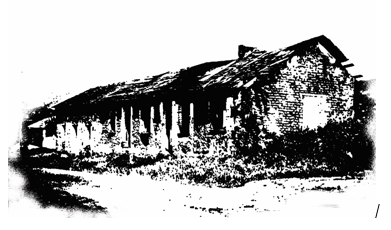
The remains of the Warders' Quarters, Toodyay, circa 1930s (Image: Transparency produced from original photograph, Battye Library collection).

Resident Magistrate
The management of justice in the Swan River Colony was the responsibility of the Colonial Government. Resident Magistrates were appointed for a set term by the Governor and had no formal legal training. Their duties were administrative as well as judicial.
The Resident Magistrate was able to deal with minor infringements such as drinking. However, if the charge was a criminal matter - such as murder - then the magistrate was obliged to send the convict to Perth for trial and later imprisonment at the Fremantle Gaol.


Replica convict punishment uniform.
If a convict misbehaved, he could be sent back to Fremantle for punishment. This might include being sent to work in leg irons on work parties, and being forced to wear the particoloured or ‘magpie’ uniform. It was designed to further shame the convict and make him stand out (Image: WA Museum Boola Bardip display, 2022).

Joseph Strelley Harris (Resident Magistrate, Toodyay District, 1850-1861)
Harris was the fourth Resident Magistrate appointed to Toodyay. It was he who selected the permanent site for the Toodyay Convict Hiring Depot.
One of Harris’ early initiatives was a Fire Brigade, made up of ticket-of-leave holders and Aboriginal men that could be hired from the Convict Depot. The Brigade received rations and a small monthly allowance from the government. In 1854, cost-cutting measures by Governor Fitzgerald ended the service, and Police were given the responsibility of bushfire patrols during the summer.

Alfred Durlacher (Resident Magistrate, Toodyay District, 1861-1865)
During 1860 there had been no new convict arrivals in the Colony, and many of the Depot buildings continued to remain vacant. In 1861, the Colonial Government took over the unused buildings on the Depot site. Durlacher moved into the residence formerly occupied by the Depot Assistant Superintendent.
In August 1861, bushranger Moondyne Joe was arrested for horse-stealing and placed in the Toodyay Convict Hiring Depot lock-up. He managed to break out, and during his escape - his first ever escape from custody - he stole Durlacher’s new saddle and bridle, as well as his horse.
A furious Durlacher wrote to the government urging the construction of a larger, more secure lock-up. Towards the end of 1864, the Newcastle Gaol was finally completed, with the Police assuming control in 1865.


Joseph Bolitho Johns, better known as Moondyne Joe after the remote western part of the Toodyay Valley where he settled after receiving a conditional pardon in 1855.



Newcastle Gaol, 1960s (Image: Shire of Toodyay, 2001.1394).

Military Personnel
During most of the transportation era, Western Australia’s convict system was administered by staff from the Corps of Royal Engineers. This is a division of the British Army providing military engineering expertise.
Captain Edmund Yeamans Walcott Henderson of the Royal Engineers was Comptroller General of Convicts in Western Australia from 1851 to 1863.


E.Y.W. Henderson (Image: Royal Sappers and Miners in Western Australia).

Sappers and Miners
In late 1851, the 20th Company of Royal Engineers arrived at Fremantle, comprised of 95 Sappers and Miners, whose task was to supervise and instruct convicts. One officer who accompanied them was 21-year-old 2nd Lieutenant Edmund DuCane.
Sappers were fully-trained soldiers with added training in a variety of trades, such as bricklaying, carpentry and blacksmithing. These men served a dual role: they acted as instructing warders, supervising convicts and their labour; and conducted usual duties such as escorting convicts to and from the work site.
The colony only had a limited Police Force. If the need arose, Sappers could also be called on for military service.


Royal Sappers and Miners uniforms, 19th century (Image: Peter Southern, Pinterest).

Edmund Frederick DuCane
DuCane was given the task of overseeing the Eastern District, where he would be responsible for setting up the Convict Hiring Depots of Guildford, York and Toodyay. He was also in charge of organising the road works in the district, and later took on the role of Visiting Magistrate.
DuCane was recalled to Britain early in 1856 and went on to have a very successful career in prison administration.


Edmund Du Cane, aged 33 (Image: Nicholas Hasluck)

Enrolled Pensioner Guards
Around 1,100 retired British soldiers, known as Pensioner Guards, migrated to Western Australia during the Convict era.
These men had volunteered as guards on the ships transporting convicts to Western Australia, in response to an offer of a plot of land and help to develop it. Ownership was transferred to them after seven years.
Once the Pensioner Guards were released from permanent duty, other duties of a peacekeeping or military nature were expected of them. Many of these men became warders in charge of convicts.
Their uniform consisted of dark grey-brown trousers with a scarlet stripe down the leg, and knee-length dark blue surcoats with facings of red and yellow and dandified epaulettes. There was also a tall regulation hat, which they hated.


Enrolled Pensioner Guard, York Convict Depot (Image: The Queens Royal Surrey Regiment)

Many Pensioner Guards were Irish and Roman Catholic, and travelled to WA with their families. Three Pensioner Guards who came to Toodyay were typical.
David Gailey (1807-1881) and Francis Kirk (1807-1869) both accompanied the first group of convicts sent to Toodyay in 1851. They were allocated land at the original Toodyay town site, but this was later transferred to the permanent Convict Hiring Depot site 3km upstream.
Owen Hackett (1809-1862) came to the Toodyay district in 1856.
Thirteen allotments were marked out, and from 1852 to 1856 a number of two-roomed brick cottages were erected. This group became known as the Pensioner Village, and after 1860 the new town of Newcastle (later renamed Toodyay) developed around them.


1880s Newcastle, believed to show the Pensioner Village allotments and two-room cottages along the street known today as Stirling Terrace
(Image: State Library of Western Australia collection).

Remnants of the Pensioner Village are still visible today in Toodyay. The modified cottages of Francis Kirk (68 Stirling Terrace) and Owen Hackett (80 Stirling Terrace) are the most recognisable examples.



Hackett’s Cottage (top) and Kirk's Cottage (underneath), 2014 (Images: Wikipedia).

Gailey, Kirk and Hackett all settled in Toodyay and increased their families after arrival. They were well-regarded members of the community, and many of their descendants continued to live locally.

Police
Early colonial policemen were recruited by magistrates and worked part time.


Brass Padlock, Colonia Government issue. Likely to have been either used by the Police or at the Gaol
(Image: Shire of Toodyay, 2001.649).

Duties
Police duties were wide-ranging, and as well as law enforcement, could include collecting taxes and serving summons. Often they volunteered as mail carriers to the isolated settlers.
After convicts started arriving in the colony, the police also took on the task of registering and supervising the Ticket of Leave men.
By 1854, the police force at Toodyay consisted of a Sergeant, two Constables, and two Native Police - all mounted. The Native Police dealt with matters associated with Aboriginal people. At this time, the police were based in the original Toodyay township where their barracks, stables and lock-up had been established.


PC George Worth, WA Police Officer 1869-75.This photograph shows the uniform worn by Police Officers at the time.
Western Australian police officers were first issued uniforms in 1857 (Image: Royal Western Australian Historical Society (Inc.), State Library of Western Australia 5002B/22).

In 1856, the Toodyay Convict Hiring Depot was downgraded. After serious flooding in 1857 and 1859, it was decided to relocate the police to higher ground at the Depot. The Convict Depot site was surveyed and plans were submitted for the new town of Newcastle. The size of the Depot was reduced considerably, and in 1861 the police took over the Commissariat, the Sappers’ quarters, and the well/privies/stables at that site.
The Convict Depot reopened in 1862. The Newcastle Gaol was then built by convict labour and handed over to the police in 1865.
The Depot finally closed in 1872, and the remaining buildings were handed over to the Colonial government. Following this, the Sergeant of Police moved into the Warders Quarters.


John Thomas Peacocke (pictured with his wife Mary), Sergeant in Charge of Newcastle Police during the 1870s
(Image: Shire of Toodyay, 2001.725).


Truncheon or cosh (Image: Shire of Toodyay, 2001.755).

The closing down of the Convict System brought about the need for a further police presence in the colony, to control the growing numbers of men receiving their ticket of leave and conditional releases.

Pastoral and Medical Care
Pastoral care provided spiritual guidance. It was felt religion was the best way to turn convicts away from the evils of crime. Attendance at daily religious services was compulsory.

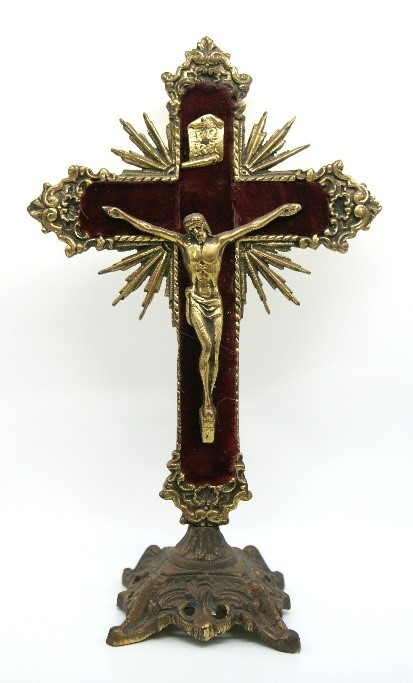
Crucifix on brass stand (Image: Shire of Toodyay, 2017.15).

Throughout the 1850s, the amount of Catholic prisoners increased. Before transportation, West Australian settlers were mainly Protestant, but Irish prisoners and Pensioner Guards saw an increased number of Catholics arriving in the Colony.
Raffaele Martelli was Toodyay’s first Catholic priest, and Charles Harper was Toodyay’s first Anglican minister. Both men ministered to convicts as well as free settlers, and they became firm friends.

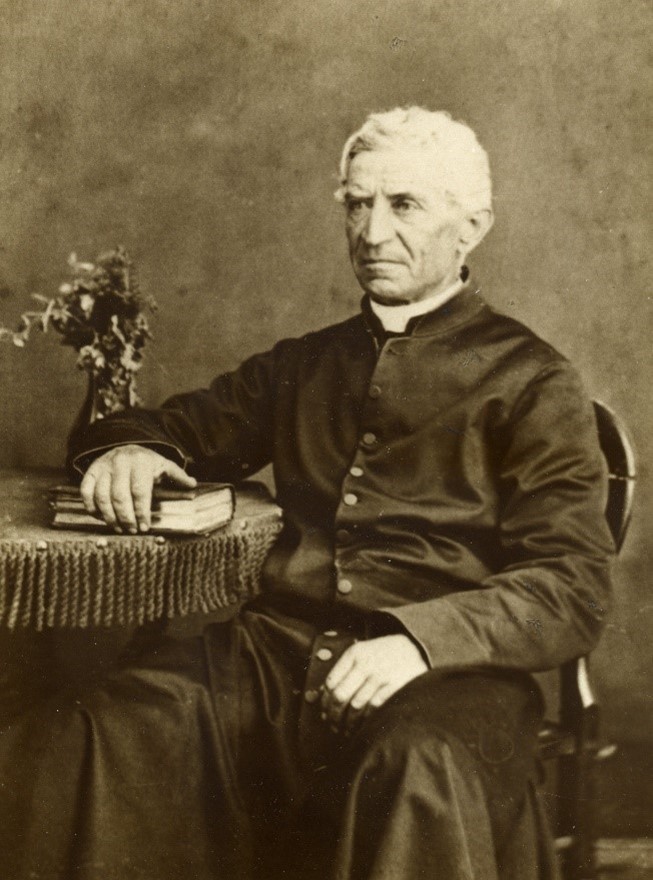
Raffaele Martelli (Image: Wikipedia).

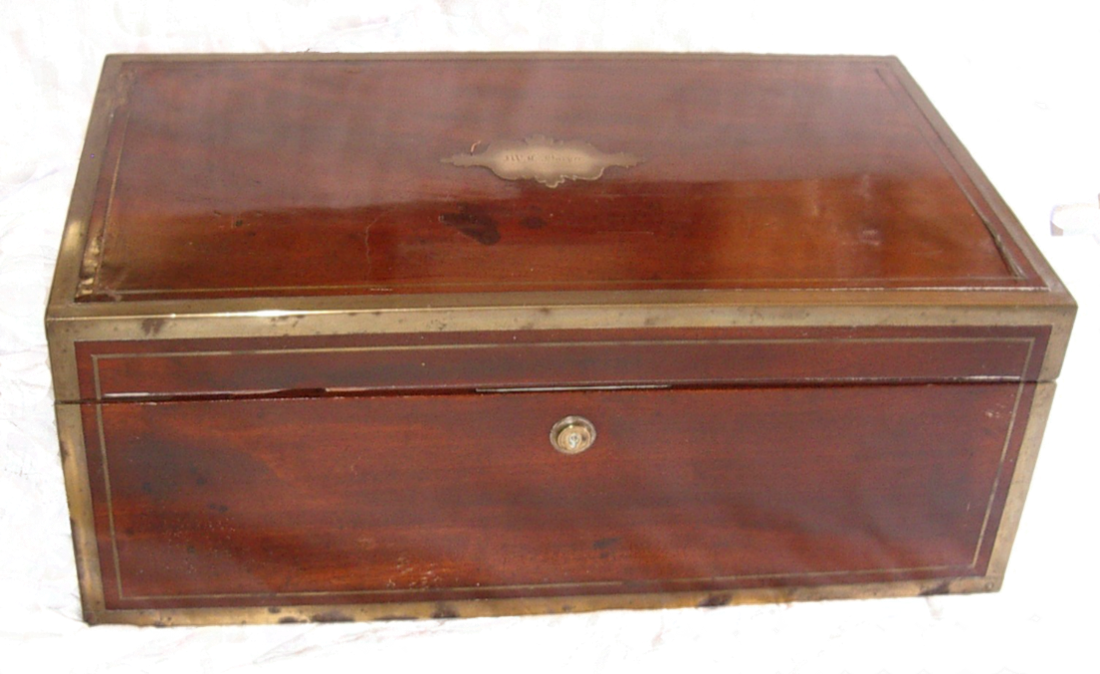
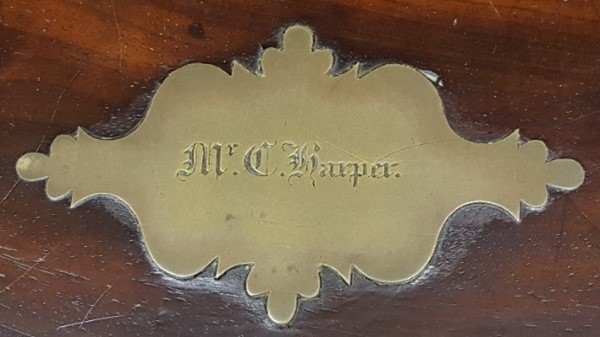
Travelling writing case with engraved name plate, owned by Charles Harper (Images: Shire of Toodyay, 2000.25).

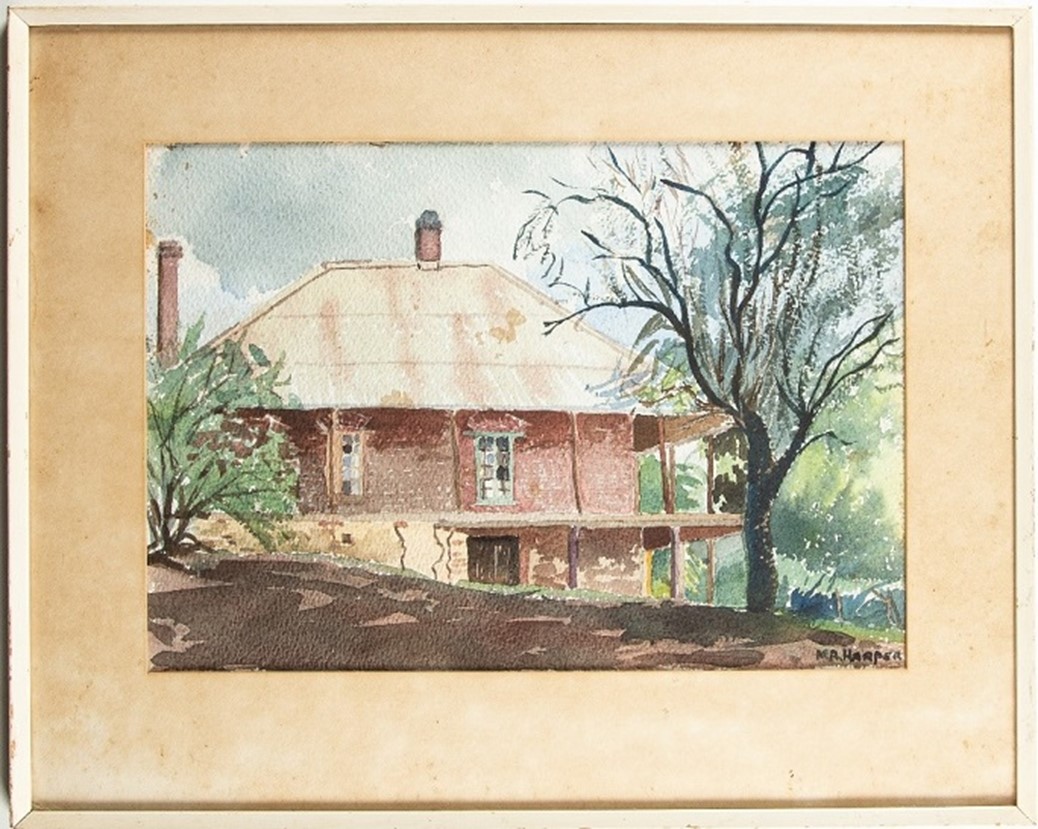
“Braybrook”, the home of Charles Harper at Newcastle (later renamed Toodyay). Demolished in the 1960s when a railway line realignment was undertaken for the standard gauge railway; and previously identified as another building associated with the Convict Depot – the original home of the Depot Superintendent, known as the Residency – which was also demolished to make way for the new railway line. The artist may have been Mary Alison Harper, who was the second wife of Prescott Henry Harper, the grandson of Charles Harper (Image: Shire of Toodyay art collection).

In 1854, an Infirmary was constructed at the Toodyay Convict Hiring Depot. It was a rectangular brick building used as a hospital.

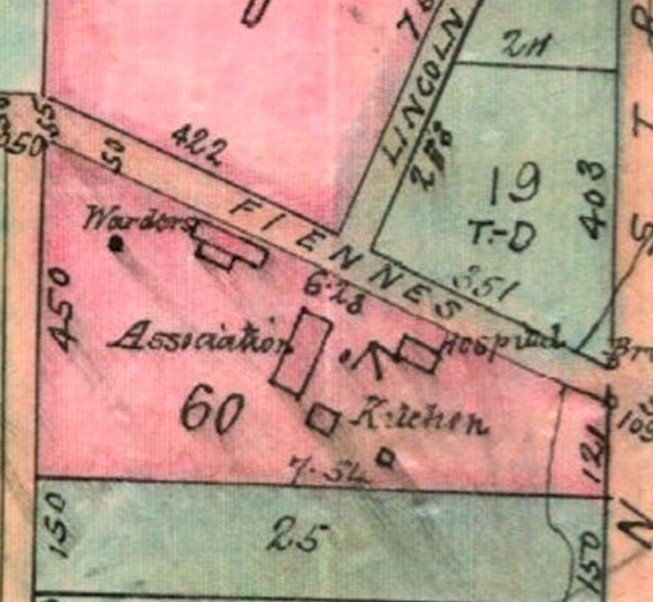
Cropped section of Newcastle subdivision plan, c1861, showing buildings in the central convict depot area, including the hospital
(Image: State Records Office, Item 28, Cons 3850).

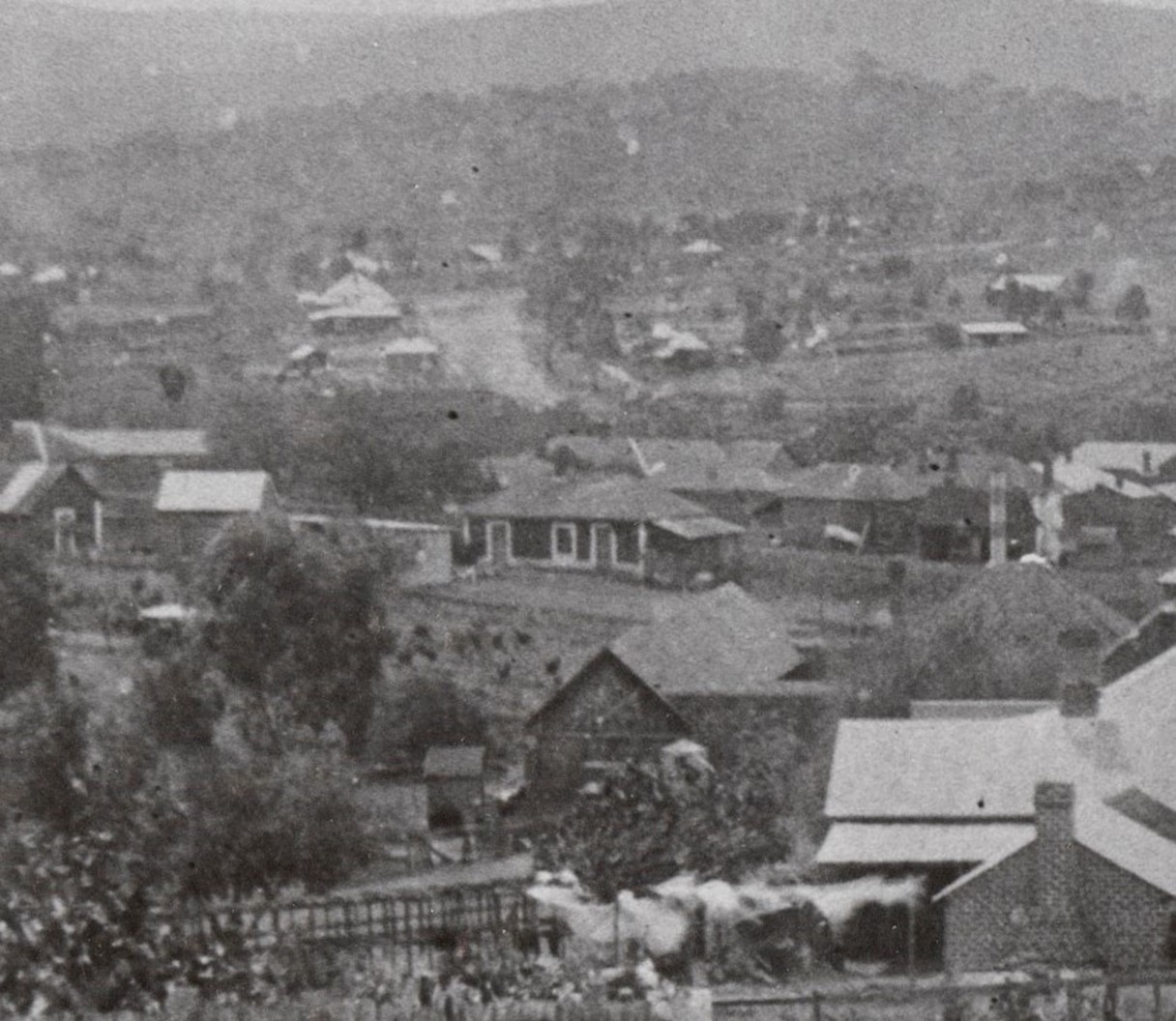
Newcastle c1896/7. The Infirmary building, located within the former Convict Depot site, has the white-framed doors.
It appears the old Depot barracks have been demolished, but the new Courthouse has yet to be built (Image: Detail from photograph, State Library of Western Australia, 3793B_2).

Dr. Alfred Green
The first Resident Medical Officer at the Toodyay Convict Hiring Depot was Dr. Alfred Green. In 1856, he was dismissed from office when a patient died - allegedly from neglect while the doctor was drunk.

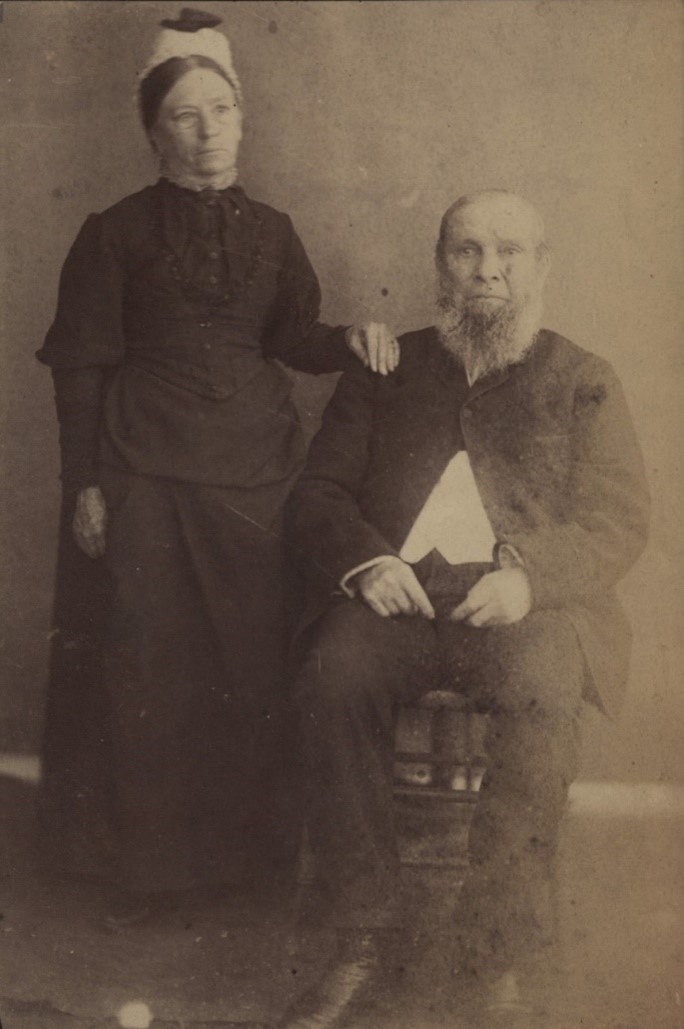
Dr. Alfred Green and his second wife, Maria Turner. Dr. Green married Maria in 1867, following the death of his first wife.
He died in Northam in 1895 at the age of 90 (Image: Newcastle Gaol Museum, 2001.1214).

Dr. Arthur Edwards Growse
After operations at the Toodyay Convict Hiring Depot were reduced in 1856, an orderly remained to provide any medical assistance required by ticket-of-leave holders still working in the district.
In 1856, Dr. A.E. Growse became the Residential Medical Officer for the Toodyay District, and also worked from the Depot Infirmary. He remained in this position after the Depot reopened in 1862 until its final closure in 1872, when he transferred to Guildford.

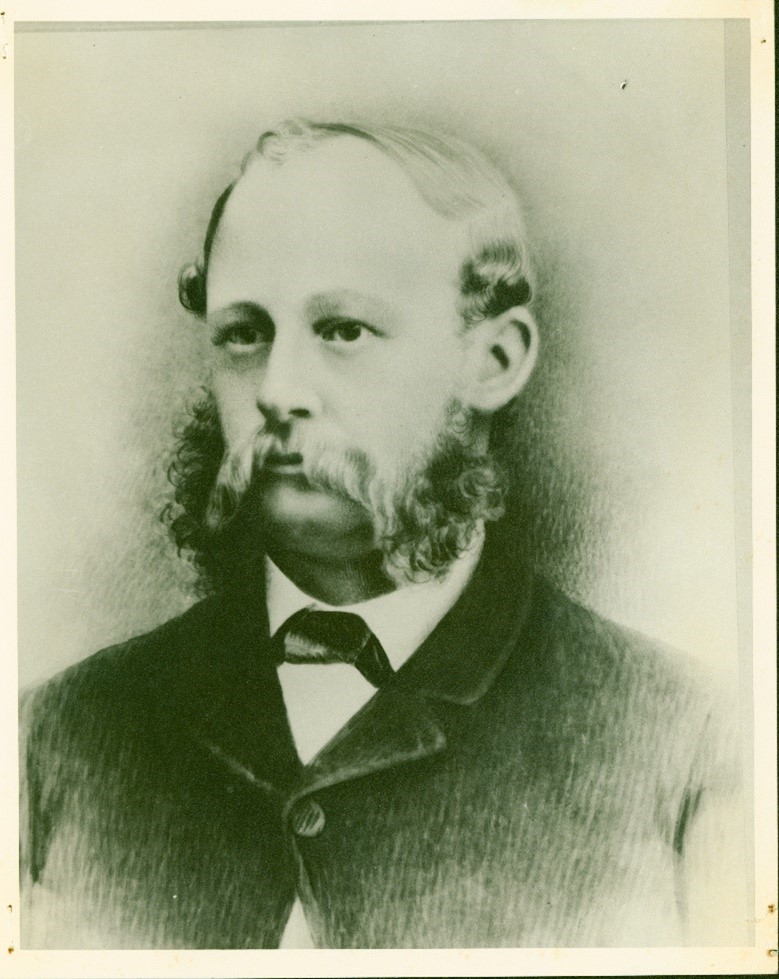
Dr. A.E. Growse (Image: Newcastle Gaol Museum, 2001.1214).

After the site was handed over to the West Australian Government, the Infirmary continued to serve as a Colonial Hospital.

Legacy
The impact of the Convict era continued to be felt for decades after transportation ceased.
People
Pensioner Guards
Pensioner Guards and their families were willing settlers. The Pensioner Village of allotments and houses remained after the Depot closed. It became the nucleus of the new community of Newcastle (renamed Toodyay in 1910).
Convicts
Following their release, those with trades had an opportunity to find employment locally. Most, however, had to settle for seasonal farming or unskilled work, and led a nomadic life on the fringes of respectable society. Very few were reunited with families left behind in Britain. Around 90% remained single for the remainder of their lives.

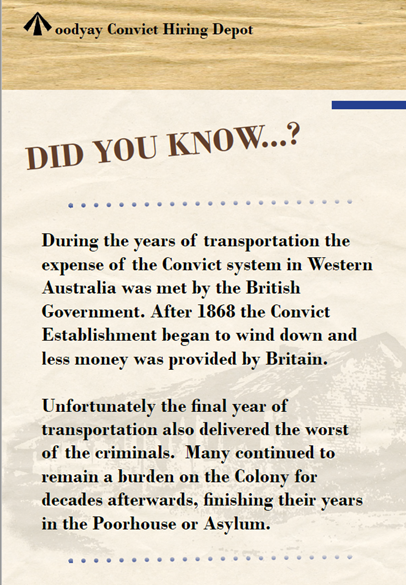

Photographs of convicts are rare. The following images show mug shots of former convicts, previously associated with Toodyay, who later reoffended and were sentenced to serve more time at Fremantle Prison.
It was not until after 1888 that Fremantle Prison inmates were photographed. In many cases, it was several decades since these men had been transported.
These images were originally published in the 2017 book Australia’s Last Convicts – Reprobates, Rogues and Recidivists by Friends of the Battye Library, and have been reproduced with their permission.

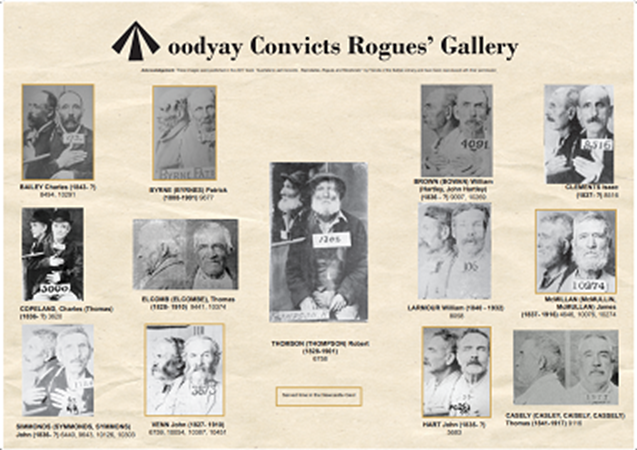
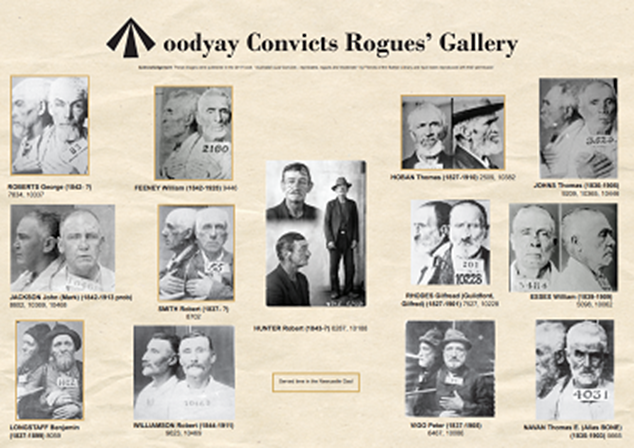

After its final closure, the Toodyay Convict Depot buildings were adapted for other purposes. Many were occupied by the police; others became a hospital, a school, a courtroom and a magistrate’s office.

Buildings
It wasn’t until after the late 1880s - following the arrival of the railway to Newcastle and the discovery of gold in Western Australia - that the Toodyay district finally began to prosper. By then, many of the old Depot buildings had fallen into disrepair. As newer facilities were constructed, the Depot buildings were progressively demolished.

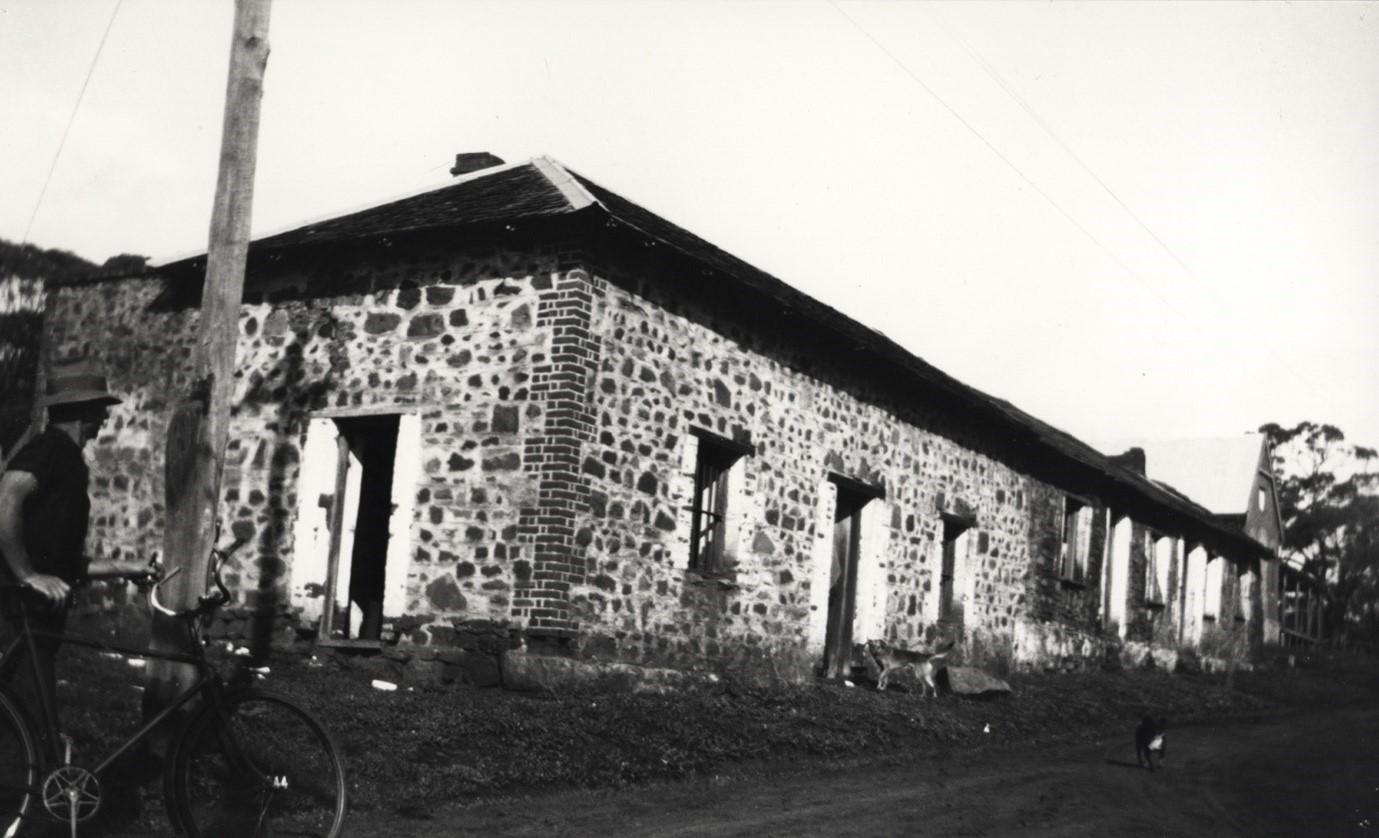
Warders’ Quarters, Toodyay, c1930. Demolished in the 1930s. The building was located in front of the current Shire of Toodyay Administration Centre on Fiennes Street
(Image: Newcastle Gaol Museum, 2001.1199).

Heritage Listing
In 2014, the archaeological remains of the central section of the former Toodyay Convict Depot were State heritage listed. These remains are buried beneath and around the Shire of Toodyay’s current Administration Centre (the Old Courthouse).
The remains include the foundations of the barracks, hospital, kitchen and warders’ quarters.

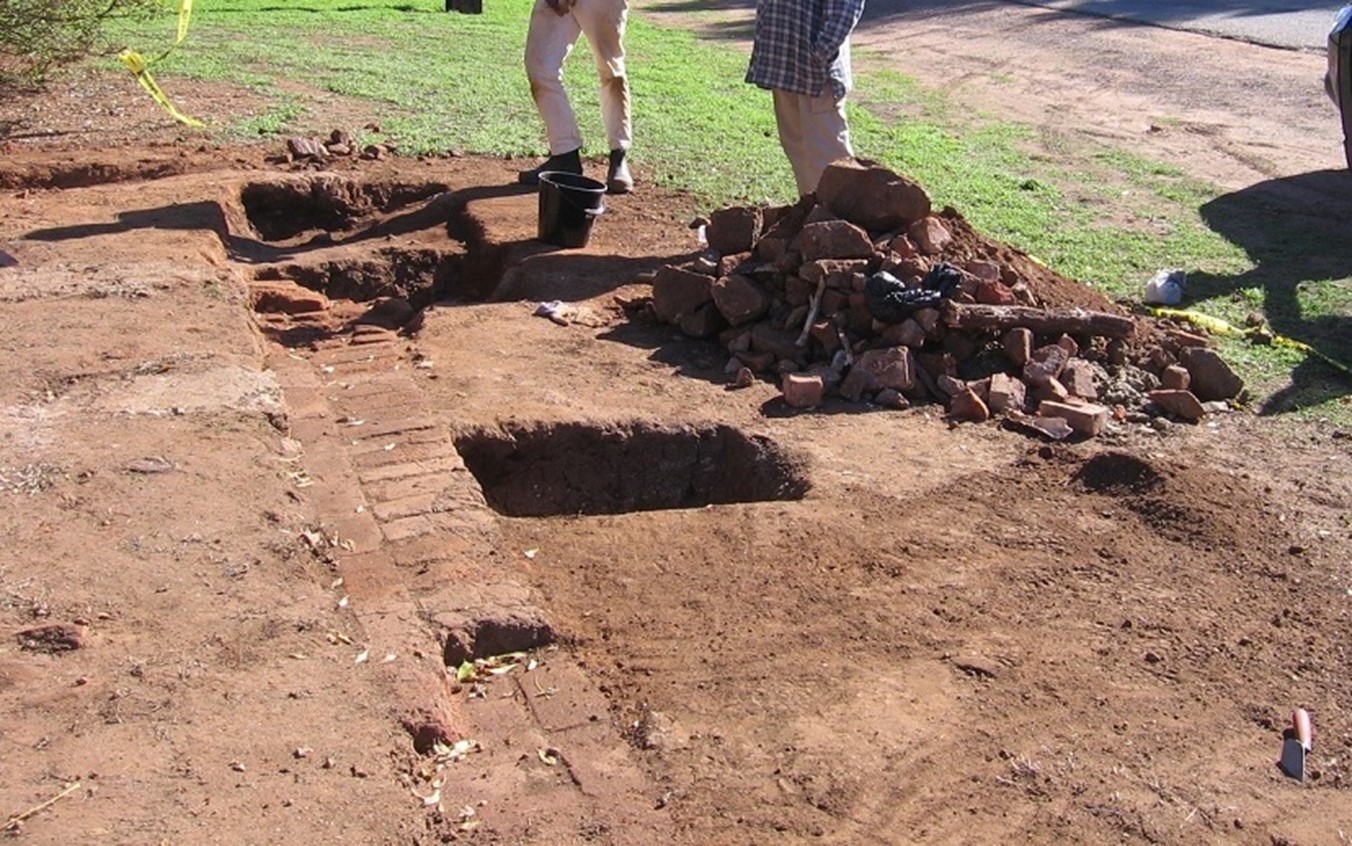
2010 archaeological investigation by University of WA archaeology students, on remains associated with the Depot Superintendent’s quarters, downhill from the central Toodyay Convict Depot site. This site, opposite the current Toodyay railway station, is also included in the State Heritage Listing of the archaeological remains of the Toodyay Convict Depot (Image: Beth Frayne, 2010).

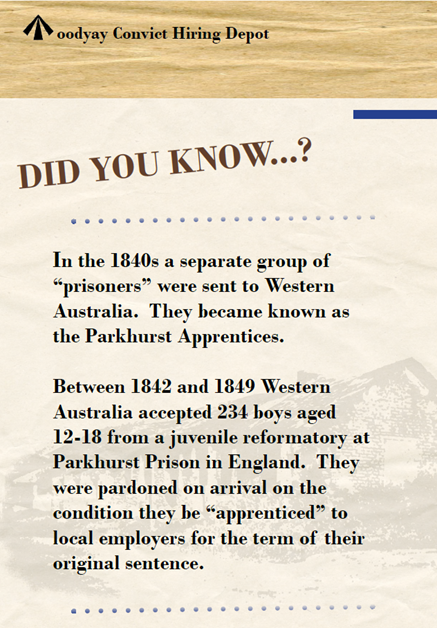

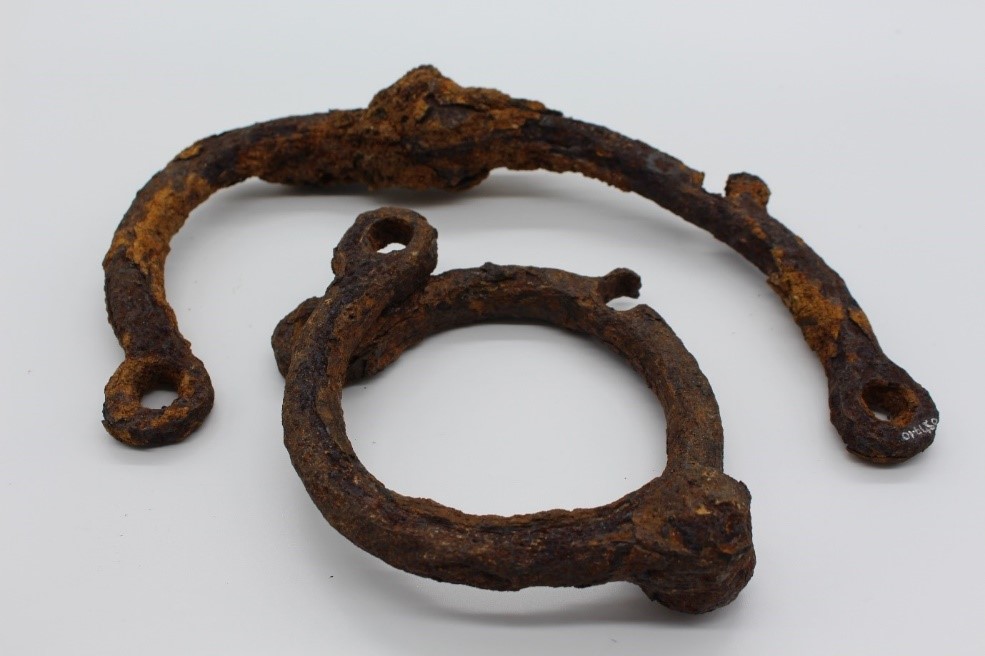
Leg irons, thought to date from 1850s-1860s. These were found in the Newcastle Gaol courtyard well (Image: Shire of Toodyay, 2001.645).

More information
The following links offer further information about Toodyay’s convict past:

Acknowledgements
- Alison Cromb - For assistance throughout the development of the original exhibition at the Newcastle Gaol, much of which was based upon her book about the Toodyay Convict Depot, The History of the Toodyay Convict Depot – a Tale of the Convict Era of Western Australia (2010)
- Friends of Battye Library (Gillian O’Mara) - Convict Records of Western Australia (1990, updated 2016)
- Toodyay Historical Society
- Eva Smith and the Convict Special Interest Group (Western Australian Genealogical Society)
- Fremantle Prison - Convict Daily Life